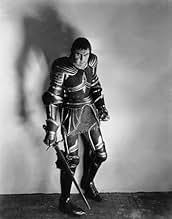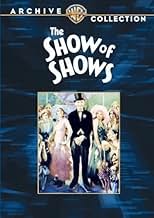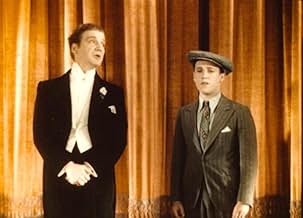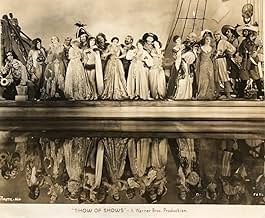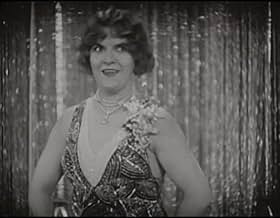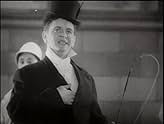Agrega una trama en tu idiomaIn 1929, the studio gave the cinema its voice and offered audiences a chance to hear their favorite actors and actresses from the silent-screen era. For the first time, they can be heard in ... Leer todoIn 1929, the studio gave the cinema its voice and offered audiences a chance to hear their favorite actors and actresses from the silent-screen era. For the first time, they can be heard in a gaudy, grandiose musical-comedy revue. But also appearing are actors and actresses from ... Leer todoIn 1929, the studio gave the cinema its voice and offered audiences a chance to hear their favorite actors and actresses from the silent-screen era. For the first time, they can be heard in a gaudy, grandiose musical-comedy revue. But also appearing are actors and actresses from the first 'talkies', stars from Broadway, and, of course, German shepherd Rin-Tin-Tin. Fra... Leer todo
- Dirección
- Guionistas
- Elenco
- Premios
- 2 premios ganados en total
- Performer in 'Meet My Sister' Number
- (as Mimi Vendrell)
- Joe Burke
- (as Joe Burke)
- Dirección
- Guionistas
- Todo el elenco y el equipo
- Producción, taquilla y más en IMDbPro
Opiniones destacadas
Contributing also as a writer, host Frank Fay does a good job. The studio's biggest star at the time was Richard Barthelmess (rising from #8 in 1928 to #7 in 1929 according to the annual Quigley Poll of Box Office stars); he does not sing or dance, preferring to briefly appear as a dignified presenter. The legendary Al Jolson does not appear at all, but Sid Silvers imitates him well. John Barrymore contributes a fine excerpt as "Richard III" from "Henry VI" - rare celluloid from the Shakespearian maestro...
Another highlight is the biggest hit song from the show, "Lady Luck" performed memorably by band-leader Ted Lewis (who took it to #3 on the record charts) and singer-guitarist Nick Lucas (who helped keep Lewis from rising higher by locking down #1 for ten weeks with his "Tip Toe Through the Tulips"). Of the many cover versions, "Singin' in the Bathtub" (a good-natured poke at MGM's "Singin' in the Rain") rose to #10 in a version by Guy and Carmen Lombardo; here, Winnie Lightner contributes a vibrant version.
***** The Show of Shows (11/21/29) John G. Adolfi ~ Frank Fay, Nick Lucas, Winnie Lightner, John Barrymore
In brief, THE SHOW OF SHOWS musical program features: PROLOGUE UNIQUE: Hobart Bosworth as an executioner and HB Warner as the victim in a brief skit set during the French Revolution; THE MILITARY PARADE: lead by Monte Blue and marching and drum playing West Point cadets; FLORADORA GIRLS: Myrna Loy, Marian Nixon, Ben Turpin, Lupino Lane, and many others in 1890s costumes; THE PIRATE NUMBER: featuring Ted Lewis with motion picture pirates including Noah Beery, Tully Marshall, etc.; EIFFEL TOWER: Georges Carpentier; RECITATIONS: Beatrice Lillie, Louise Fazenda, Lloyd Hamilton and Frank Fay, later going into their song, "Your Mother and Mine"; EIGHT SISTER ACT: Hosted by Richard Barthelmess, followed by sisters including Dolores and Helene Costello singing "Meet My Sister," along with Loretta Young and Sally Blane, Sally O'Neil and Molly O'Day, Alice and Marceline Day; Marion Byron and Harriett Lake; and others. Following this number comes a title card that reads INTERMISSION: TEN MINUTES (which is usually eliminated from most TV prints); SINGING IN THE BATHTUB: Winnie Lightner, which concludes with Lightner and Bull Montana singing "You Were Meant for Me"; IRENE BORDONI HERSELF: Bordoni singing "Just an Hour of Love"; Chinese FANTASY: Introduced by Rin-Tin Tin; with Nick Lucas singing "Li-Po-Li" and Myrna Loy dancing (this number now can be seen in its restored two-strip Technicolor); FAY AND SILVERS: Amusing skit with Sid Silvers stepping in and auditioning for a solo spot, showing Frank Fay his own imitation of Al Jolson by singing "Rock-a-Bye Your Baby With a Dixie Melody"; BICYCLE BUILT FOR TWO: Chester Conklin, Douglas Fairbanks Jr., Chester Morris; Gertrude Olmstead, Sally Eilers, among others; BLACK AND WHITE: Introduced by Sid Silvers, danced by chorus girls dressed up in black and white dresses; YOUR LOVE IS ALL THAT I CRAVE: Sung by Frank Fay (he finally got to do his solo); KING RICHARD III: Introduced and recited by John Barrymore; Mexican MOONSHINE: Comedy sketch with Monte Blue as a condemned man, and Frank Fay as his executioner, accompanied by Lloyd Hamilton, Albert Gran and others as soldiers; LADY LUCK FINALE: Sung by Alexander Gray with Betty Compson briefly seen as Lady Luck; and STARS: with the entire cast appearing with their heads poked through holes in canvas singing "Lady Luck", especially John Barrymore making facial gestures while he pretends to be singing along with the others.
THE SHOW OF SHOWS is fortunate to have survived almost intact after all these years, considering how many movies of 1929 are no longer available for viewing. The most memorable performer besides John Barrymore (whom I wished could have been the master of ceremonies instead of Fay), is Winnie Lightner, whose energetic and unique comedic style, in the persona of of future vibrant singers as Martha Raye or Betty Hutton combined, who not only sings in the bathtub, but lightens up the rough spots by singing "Ping Pongo," And then there's Nick Lucas singing "Lady Luck" and "That's the Only Song I Know" with his guitar.
A predecessor to the once popular fad of TV variety shows of the 1950s and '60s, THE SHOW OF SHOWS which is one from the time capsule, is worthy entertainment that should be viewed at least once, and to get the feel of the bygone days of vaudeville, here captured on film Hollywood style. WPHL, Channel 17, in Philadelphia, was one of the very few known commercial television stations to frequently play THE SHOW OF SHOWS in the early 1970s (final air date: December 31, 1974). In later years when brought over on cable, it was shown on Turner Network Television (TNT) from 1988 to 1993, and later on Turner Classic Movies (more frequently prior to 1997). (***)
The movie is quite a spectacle, though nowadays its value is mostly as a curiosity for hardcore film buffs. The songs generally aren't that great and the performances aren't always polished, though everybody seems to be having fun. Much of the cast is made up of largely forgotten stars of the late silent/early sound era that most modern viewers wouldn't recognize. But it's a real treat for film historians.
I'm a big fan of old movies and classic Hollywood, and many of the featured stars are obscure even to me. Most of the stars are identified at some point in the film, though countless others are mixed into scenes with little fanfare. Without identification I was able to spot Myrna Loy, Ben Turpin, Chester Morris, Richard Barthelmess, Douglas Fairbanks Jr., John Barrymore, and Monte Blue. And I'm familiar, to varying degrees, with people like Frank Fay, Winnie Lightner, Louise Fazenda, Dolores Costello, Noah Beery, and Tully Marshall.
Frank Fay emcees the proceedings, tying the various acts together and introducing the stars. His verbal comedy shtick is a good fit for talkies and he does a pretty good job.
An early highlight is Winnie Lightner's upbeat comedy song "Ping Pongo". Louise Fazenda, Fay, Lloyd Hamilton, and Beatrice Lillie do a recitation sketch that's pretty funny, though it stretches a little too long. There's a number featuring notable screen villains as pirate versions of themselves (singing pirates, naturally). Another features several pairs of movie star sisters, including Loretta Young and Sally Blane, who look freakishly alike. Lightner also sings "Singin' in the Bathtub", a tune I know from old Looney Tunes cartoons. John Barrymore hams it up with a Shakespeare soliloquy as Richard III.
I was surprised and delighted halfway through to see an exotic number in two-strip Technicolor. Apparently most of the film was shot in color, but the surviving print is in black & white with the exception of this segment.
It's great seeing so many Hollywood personalities doing fun little acts and musical numbers. Everybody seems to be having a good time, putting on a big show. Some names and faces are more recognizable than others, but the film is a fascinating glimpse at the stable of Warner Bros. talent at this transitional point in cinema history.
A musical spectacular from the infancy of the sound era, THE SHOW OF SHOWS is literally presented as a stage production, with fairly static cameras and sometimes clunky framing. Sometimes the closed stage curtain fills the top three-quarters of the frame while a chorus line dances along the bottom edge. In one song voices drop out of range of the microphone as the singers move across the stage. Some of the extended crowd choreography gets tiresome, but the comedy is good for a few laughs. And it's always fun trying to identify the stars in the ensemble scenes.
6/10 for entertainment value, but 7/10 as a historical curiosity.
The purpose of the all-star revue was to showcase a particular studio's silent stars in speaking roles, and show that they could make the transition. However, Warner Bros. seems to have forgotten this and employs many acts and stars that they didn't even have under long-term contract such as Ben Turpin, Lloyd Hamilton, Beatrice Lillie, and even a marching band. Meanwhile, their biggest talent - Al Jolson - is noticeably absent. Even at a high salary he could not be compelled to join in. Almost every act is overly long and the film plays like a dozen or so Vitaphone shorts strung together with no continuity. The finale is also overly long, but it is really enjoyable with all of its dance numbers.
The highlights of the film are two numbers from Winnie Lightner - "Pingo Pongo" and "Singin in the Bathtub", a couple of numbers with Nick Lucas, John Barrymore performing Shakespeare, and the Chinese Fantasy "Li Po Li" with Nick Lucas and Myrna Loy. This last number is the only part of the film that survives in Technicolor, and it really is quite attractive. Reasonably enough, the players in these good acts were long-term Warner Bros. stars so perhaps the director knew how to play to their strengths since he was familiar with them.
This film acts as a snapshot at an odd point in film history - the year 1929, which was the bridge year between two eras - the silent and sound eras, and the roaring 20's and the Great Depression. Just two years later this same film would have had an entirely different cast, as Warner Bros. would abandon its silent era stars and the stars they hired just to produce the early musicals in favor of those stars that gave Warner Bros. its distinctive urban look and feel - James Cagney, Joan Blondell, Edward G. Robinson, and others.
Generally superior, I think, to MGM's "Hollywood Revue of 1929," and worth watching if you can
¿Sabías que…?
- TriviaAt its New York City premiere at the Winter Garden Theatre, some musical numbers were projected on a larger, wider screen by a system called Magnascope, which had been in occasional use since 1924.
- Citas
Executioner - Guillotine Sequence: Prologue is Dead! On with the Show of Shows!
- ConexionesFeatured in The Voice That Thrilled the World (1943)
Selecciones populares
- How long is Show of Shows?Con tecnología de Alexa
Detalles
Taquilla
- Presupuesto
- USD 850,000 (estimado)
- Tiempo de ejecución2 horas 8 minutos

